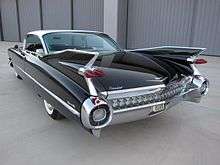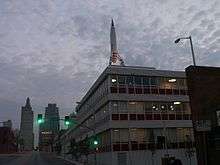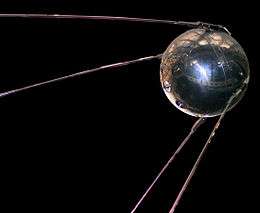Space Age
The Space Age is a period encompassing the activities related to the Space Race, space exploration, space technology, and the cultural developments influenced by these events. The Space Age is generally considered to have begun with Sputnik 1 in 1957, continuing to the present day.

Beginning
The Space Age began with the development of several technologies that converged with the October 4, 1957 launch of Sputnik 1 by the Soviet Union. This was the world's first artificial satellite, orbiting the Earth in 98.1 minutes and weighing 83 kg (183 lb). The launch of Sputnik 1 ushered in a new era of political, scientific and technological achievements that became known as the Space Age,[2] by the rapid development of new technology and a race for achievement, mostly between the United States and the Soviet Union. Rapid advances were made in rocketry, materials science, and other areas. Much of the technology originally developed for space applications has been spun off and found additional uses. One such example is memory foam.
The Space Age reached its peak with the Apollo program that captured the imagination of much of the world's population. The landing of Apollo 11 was watched by over 500 million people around the world and is widely recognized as one of the defining moments of the 20th century. Since then, public attention has largely moved to other areas.[3]
In the United States, the Space Shuttle Challenger disaster in 1986 marked a significant decline in crewed Shuttle launches. Following the disaster, NASA grounded all Shuttles for safety concerns until 1988.[4] During the 1990s funding for space-related programs fell sharply as the remaining structures of the now-dissolved Soviet Union disintegrated and NASA no longer had any direct competition.
Since then, participation in space launches has increasingly widened to include more governments and commercial interests. Since the 1990s, the public perception of space exploration and space-related technologies has been that such endeavors are increasingly commonplace.
NASA permanently grounded all U.S. Space Shuttles in 2011. NASA has since relied on Russia to take American astronauts to and from the International Space Station.[5]
Present period
In the early 21st century, the Ansari X Prize competition was set up to help jump-start private spaceflight. The winner, Space Ship One in 2004, became the first spaceship not funded by a government agency.[6]
Several countries now have space programs; from related technology ventures to full-fledged space programs with launch facilities.[7] There are many scientific and commercial satellites in use today, with thousands of satellites in orbit,[8] and several countries have plans to send humans into space.[9][10] Some of the countries joining this new race are France, India, China, Israel and the United Kingdom, all of which have employed surveillance satellites. There are several other countries with less extensive space programs, including Brazil, Germany, Ukraine, and Spain.[11]
As for the United States space program, NASA is currently constructing a deep-space crew capsule named the Orion. NASA's goal with this new space capsule is to carry humans to Mars. The Orion spacecraft is due to be completed in the early 2020s. NASA is hoping that this mission will “usher in a new era of space exploration.”[11]
Another major factor affecting the current Space Age is the privatization of space flight. There are two major companies, Boeing and SpaceX, that are taking a large part in research and innovation. Elon Musk, the owner of SpaceX, has stated the ultimate goal of putting a colony of 1 million people on Mars and in 2018, it launched its largest rocket, bringing this goal closer to reality.[12] Blue Origin, a private company funded by Amazon.com founder Jeff Bezos, is developing rockets for use in space tourism, commercial satellite launches, and eventual missions to the Moon and beyond.[13] Richard Branson's company Virgin Galactic is concentrating on launch vehicles for space tourism.
Chronology
| Date | First ... | Mission | Person(s) | Country |
|---|---|---|---|---|
| June 20, 1944 | Artificial object in outer space, i.e. beyond the Kármán line | V-2 rocket, test flight | – N/A | Germany |
| October 24, 1946 | Pictures from space (105 km)[14][15][16] | U.S.-launched V-2 rocket from White Sands Missile Range, New Mexico. | – N/A | United States |
| February 20, 1947 | Animals in space | U.S.-launched V-2 rocket on 20 February 1947 from White Sands Missile Range, New Mexico.[17][18][19] | - fruit flies | United States |
| October 4, 1957 | Artificial satellite | Sputnik 1 | – N/A | Soviet Union |
| November 3, 1957 | Animal in orbit | Sputnik 2 | Laika the dog | Soviet Union |
| January 2, 1959 | Lunar flyby, and first spacecraft to achieve a heliocentric orbit | Luna 1 | – N/A | Soviet Union |
| September 12, 1959 | Impacted on the Lunar surface; thereby becoming the first human object to reach another celestial body | Luna 2 | – N/A | Soviet Union |
| October 7, 1959 | Pictures of the far side of the Moon | Luna 3 | – N/A | Soviet Union |
| April 12, 1961 | Human in space | Vostok 1 | Yuri Gagarin | Soviet Union |
| May 5, 1961 | Manual orientation of crewed spacecraft and first human space mission that landed with pilot still in spacecraft, thus the first complete human spaceflight by FAI definitions[20][21] | Freedom 7 | Alan Shepard | United States |
| December 14, 1962 | Successful flyby of another planet (Venus closest approach 34,773 kilometers) | Mariner 2 | – N/A | United States |
| March 18, 1965 | Spacewalk | Voskhod 2 | Alexei Leonov | Soviet Union |
| December 15, 1965 | Space rendezvous | Gemini 6A and Gemini 7 | Schirra, Stafford, Borman, Lovell | United States |
| February 3, 1966 | Soft landing on the Moon by a spacecraft | Luna 9 | – N/A | Soviet Union |
| March 1, 1966 | First human-made object to impact another planet | Venera 3 | – N/A | Soviet Union |
| March 16, 1966 | Orbital docking between two spacecraft | Gemini 8 & Agena Target Vehicle | Neil Armstrong, David Scott | United States |
| April 3, 1966 | Artificial satellite of another celestial body (other than the Sun) | Luna 10 | – N/A | Soviet Union |
| October 18, 1967 | First spacecraft to perform transmit data from the atmosphere of another planet | Venera 4 | – N/A | Soviet Union |
| December 21–27, 1968 | First humans to enter the gravitational influence of another celestial body (the Moon) and orbit it | Apollo 8 | Borman, Lovell, Anders | United States |
| July 20, 1969 | Humans land and walk on another celestial body (Moon) | Apollo 11 | Neil Armstrong, Buzz Aldrin | United States |
| December 15, 1970 | First telemetry from the surface of another planet | Venera 7 | – N/A | Soviet Union |
| April 19, 1971 | Operational space station | Salyut 1 | – N/A | Soviet Union |
| June 7, 1971 | Resident crew | Soyuz 11 (Salyut 1) | Georgy Dobrovolsky, Vladislav Volkov, Viktor Patsayev | Soviet Union |
| July 20, 1976 | Pictures from the surface of Mars | Viking 1 | – N/A | United States |
| April 12, 1981 | Reusable orbital spaceship | STS-1 | Young, Crippen | United States |
| February 19, 1986 | Long-duration space station | Mir | – N/A | Soviet Union |
| February 14, 1990 | Photograph of the whole Solar System[22] | Voyager 1 | – N/A | United States |
| November 20, 1998 | Current space station | International Space Station | – N/A | Russia |
| August 25, 2012 | Artificial space probe in interstellar space | Voyager 1 | – N/A | United States |
| November 12, 2014 | Artificial probe to make a planned and soft landing on a comet (67P/Churyumov–Gerasimenko)[23] | Rosetta | – N/A | European Space Agency |
| July 14, 2015 | Nation to have its space probes to explore all of the nine major planets recognized in 1981[24] | New Horizons | – N/A | United States |
| December 20, 2015 | Vertical landing of an orbital rocket booster on a ground pad.[25] | Falcon 9 flight 20 | – N/A | United States |
| April 8, 2016 | Vertical landing of an orbital rocket booster on a floating platform at sea.[26] | SpaceX CRS-8 | – N/A | United States |
| March 30, 2017 | Relaunch and second landing of a used orbital rocket booster.[27] | SES-10 | – N/A | United States |
| January 3, 2019 | Soft landing on the lunar far side by a spacecraft. | Chang'e 4 | – N/A | China |
| May 30, 2020 | First human orbital spaceflight launched by a private company. | SpaceX Demo-2 | Bob Behnken, Doug Hurley | United States |
Earlier spaceflights
The Space Age might also be considered to have begun much earlier than October 4, 1957, because in June 1944, a German V-2 rocket became the first manmade object to enter space, albeit only briefly.[28] Some even consider March 1926 as the beginning of the Space Age, when American rocket pioneer Robert H. Goddard launched the world's first liquid fuel rocket, though his rocket did not reach outer space.[29]
Since the V-2 rocket flight was undertaken in secrecy, it was not public knowledge for many years afterward. Further, the German launches, as well as the subsequent sounding rocket tests performed in both the United States and the Soviet Union during the late 1940s and early 1950s, were not considered significant enough to start a new age because they did not reach orbit. Having a rocket powerful enough to reach orbit meant that a nation could place a payload anywhere on the planet, or to use another term, possessed an intercontinental ballistic missile. The fact that after such a development nowhere on Earth was safe from a nuclear warhead is why the orbital standard is commonly used to define when the space age began.[30]
Arts and architecture



The Space Age is considered to have influenced:
- Automotive design
- Googie architecture
- Amusement park attraction including TWA Moonliner and Mission: Space.
- Cold War playground equipment
See also
- Space exploration
- Space Race
- Spacecraft
- Human spaceflight
- SEDS
- Space probe
- Information Age
- Jet Age
- Atomic Age
- Googie architecture (space age design movement)
- Space tourism
References
- McDougall, Walter A (Winter 2010), "Shooting the Moon", American Heritage.
- Garber, Steve. "Sputnik and The Dawn of the Space Age". History. NASA. Archived from the original on 18 November 2004. Retrieved 6 May 2013.
- "National Aeronautics and Space Administration". NASA. Archived from the original on 1996-12-31. Retrieved 2015-11-20.
- Howell, Elizabeth. "Challenger: Shuttle Disaster That Changed NASA". Space.com. Archived from the original on 4 May 2018. Retrieved 17 March 2018.
- "The New American Space Age: A Progress Report on Human SpaceFlight" (PDF). Aerospace Industries Association. Aerospace Industries Association. Archived (PDF) from the original on 25 March 2018. Retrieved 16 March 2018.
- "SpaceShipOne: The First Private Spacecraft | The Most Amazing Flying Machines Ever". Space.com. Archived from the original on 2015-11-15. Retrieved 2015-11-27.
- "Global Space Programs | Space Foundation". www.spacefoundation.org. Archived from the original on 2015-11-14. Retrieved 2015-11-27.
- "Satellites - Active Satellites in Earth's Orbit". satellites.findthedata.com. Archived from the original on 2016-10-23. Retrieved 2015-11-27.
- "Japan Wants Space Plane or Capsule by 2022". Space.com. Archived from the original on 2015-12-24. Retrieved 2015-11-27.
- "India takes giant step to manned space mission". Telegraph.co.uk. Archived from the original on 2015-11-26. Retrieved 2015-11-27.
- "The New Space Race – Who Will Take the Lead?". rcg.org. Retrieved 2018-05-08.
- "A NASA Astronaut Stays In Orbit With SpaceX And Boeing". NPR.org. Retrieved 2018-05-08.
- "Blue Origin: everything you need to know about the Amazon.com of space". TechRadar. Retrieved 2019-11-11.
- "Chronology: Cowboys to V-2s to the Space Shuttle to lasers". www.wsmr.army.mil. Archived from the original on 13 October 2014. Retrieved 4 May 2018.
- "Archived copy". Archived from the original on 2014-02-21. Retrieved 2013-01-17.CS1 maint: archived copy as title (link)
- Reichhardt, Tony. "First Photo From Space". airspacemag.com. Retrieved 4 May 2018.
- "Post War Space". postwar.com. Archived from the original on 2011-07-15.
- "The Beginnings of Research in Space Biology at the Air Force Missile Development Center, 1946–1952". History of Research in Space Biology and Biodynamics. NASA. Archived from the original on 25 January 2008. Retrieved 31 January 2008.
- "V-2 Firing Tables". White Sands Missile Range. Archived from the original on 25 January 2008. Retrieved 31 January 2008.
- "Geek Trivia: A leap of fakes". Archived from the original on 5 August 2017. Retrieved 18 August 2016.
- "Manned Space Firsts". Archived from the original on 2013-10-30. Retrieved 2016-06-30.
- See "Archived copy". Archived from the original on 2009-03-31. Retrieved 2009-07-21.CS1 maint: archived copy as title (link) under "Extended Mission"
- Chang, Kenneth (Nov 12, 2014). "European Space Agency's Spacecraft Lands on Comet's Surface". The New York Times. Archived from the original on 2014-11-12. Retrieved Nov 12, 2014.
- Talbert, Tricia (25 March 2015). "New Horizons: The First Mission to the Pluto System and the Kuiper Belt". nasa.gov. Archived from the original on 15 October 2017. Retrieved 4 May 2018.
- Chang, Kenneth (December 21, 2015). "SpaceX Successfully Lands Rocket after Launch of Satellites into Orbit". The New York Times. Retrieved December 22, 2015.
- Drake, Nadia (April 8, 2016). "SpaceX Rocket Makes Spectacular Landing on Drone Ship". National Geographic. Archived from the original on April 8, 2016. Retrieved April 8, 2016.
To space and back, in less than nine minutes? Hello, future.
- Grush, Loren (March 30, 2017). "SpaceX makes aerospace history with successful landing of a used rocket". The Verge. Archived from the original on March 30, 2017. Retrieved March 30, 2017.
- Schefter, James (1999), The Race: The Uncensored Story of How America Beat Russia to the Moon, New York, New York: Doubleday, pp. 3–49, ISBN 0-385-49253-7
- "Goddard launches space age with historic first 85 years ago today". Retrieved 2016-04-29.
- Schefter, James (1999), The Race: The Uncensored Story of How America Beat Russia to the Moon, New York, New York: Doubleday, pp. 3–49, ISBN 0-385-49253-7
External links
| Wikimedia Commons has media related to Space Age. |
| Look up space age in Wiktionary, the free dictionary. |
Interactive media
- 50th Anniversary of the Space Age & Sputnik, NASA, archived from the original on 2007-10-27.

